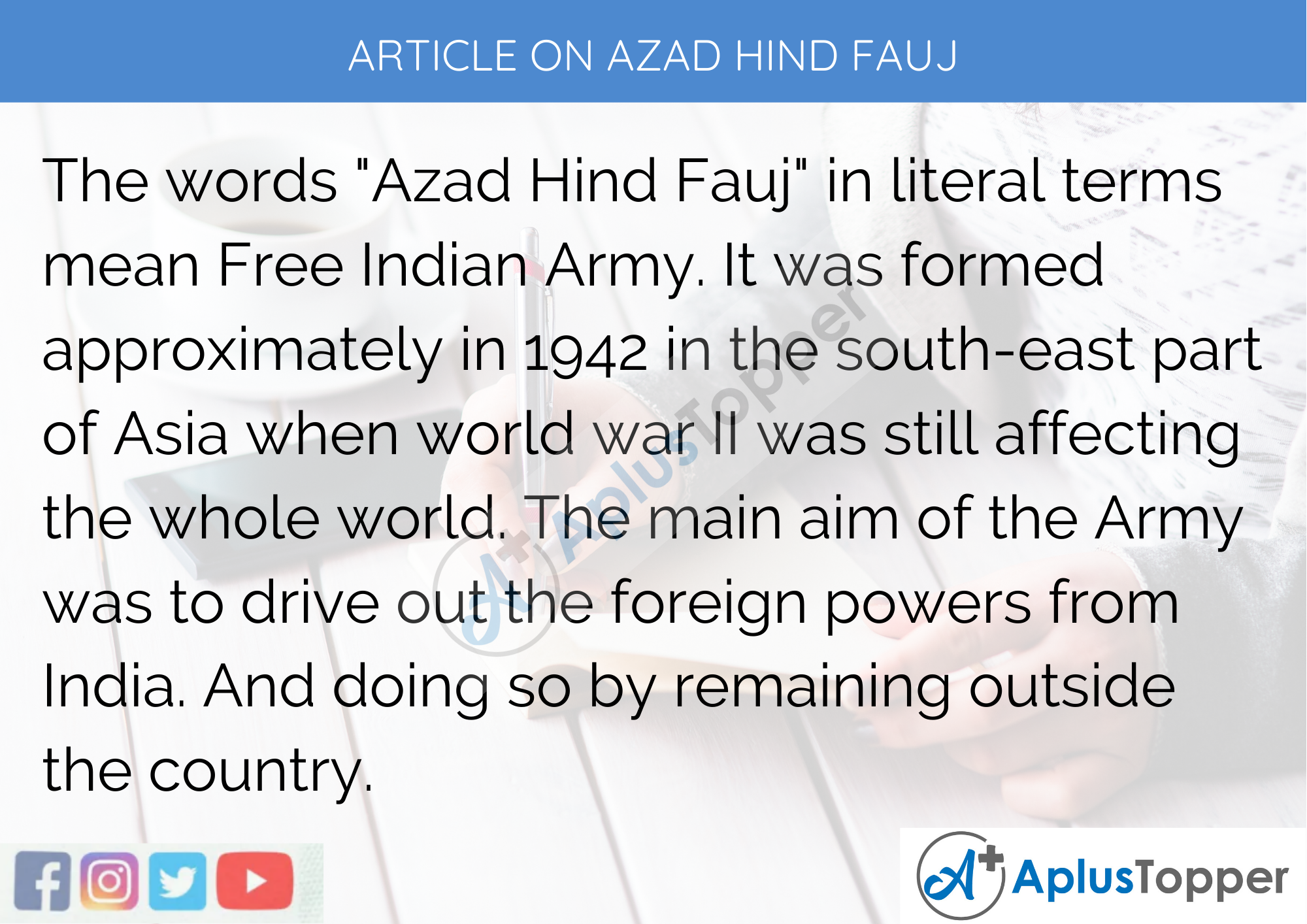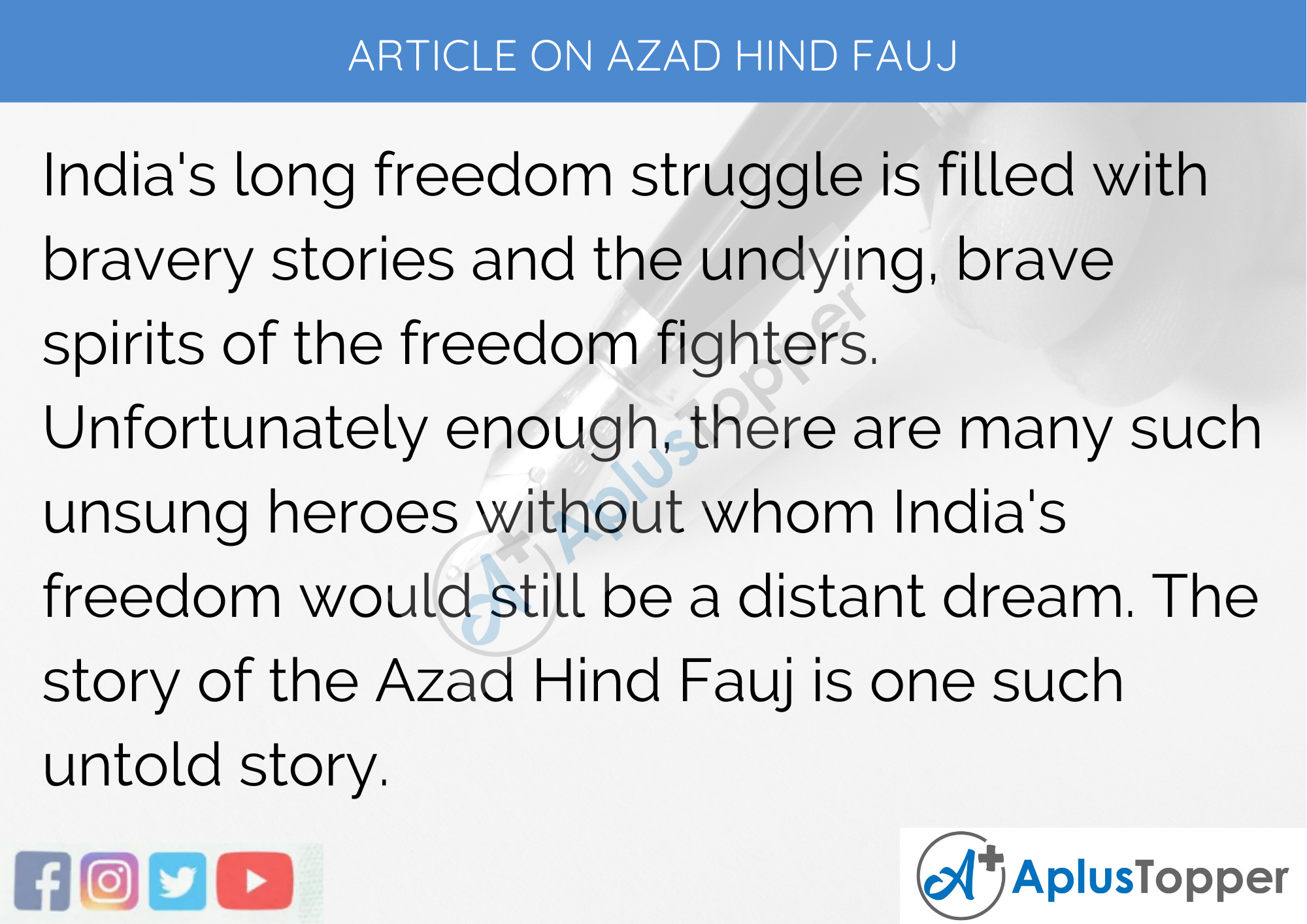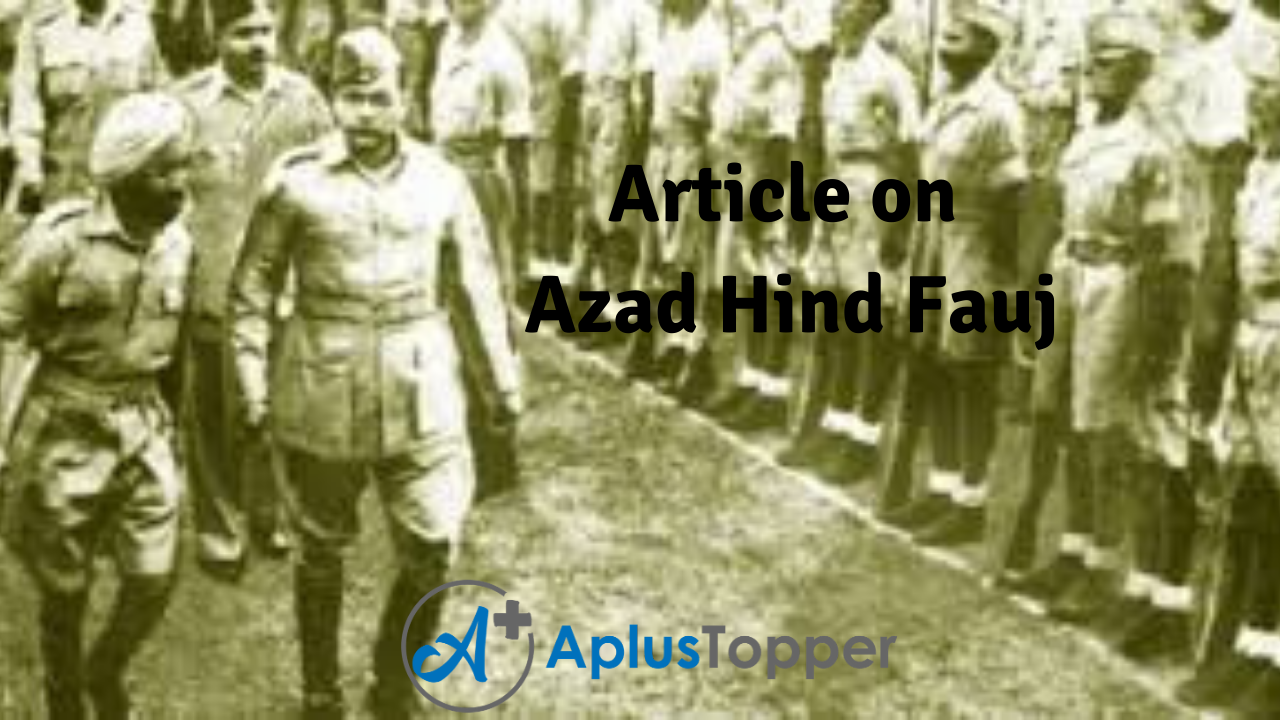Article On Azad Hind Fauj: Azad Hind Fauj or better known as the Indian National Army, was primarily formed by Rash Bihari Bose. Later, it was reformed by one of India’s greatest freedom fighters, Netaji Subhash Chandra Bose. The Fauj was formed in the year 1943, around October. The Army was a significant part of the rising political movement of that period that was shaping outside India against the British power.
The Indian Nationalists residing in the southern part of Asia played an essential role in the success of the Azad Hind Fauj.
You can read more Article Writing about people, sports, technology many more.
Long And Short Articles On Azad Hind Fauj for Students and Children in English
The topic of Azad Hind Fauj is a crucial chapter in the History of Indian Freedom struggle. Thus it is a ubiquitous topic that the students can get asked to write Articles. The following long Article on Azad Hind Fauj are useful for students of classes 7, 8, 9, and 10. However, we have also provided students from Classes 1, 2, 3, 4, 5, and 6 with a short Article on Azad Hind Fauj.

Long Article On Azad Hind Fauj 500 Words In English
The words “Azad Hind Fauj” in literal terms mean Free Indian Army. It was formed approximately in 1942 in the south-east part of Asia when world war II was still affecting the whole world. The main aim of the Army was to drive out the foreign powers from India. And doing so by remaining outside the country.
Being influenced by the organization of Mohan Singh, Netaji Subhash Chandra Bose had formed the Army with an alliance with imperial Japan. Mohan Singh’s first INA(Indian National Army) collapsed and was disbanded in late 1942. This was when Rash Bihari Bose handed over INA’s responsibilities to Bose. Under the leadership of Bose, the Army was revived and created History in the later years.
The Army started drawing ex-prisoners and the vast number of civilian volunteers from the Indian expatriate population in Malaysia and Burma.
In the later years, INA was capable of associating itself with Imperial Japan and other such axis powers. Consequently, this gave rise to several acquisitions that were leveled against the INA troops. The members were accused of being involved in Japanese war crimes.
However, this was not the only thought that revolved around the people. Some also saw them as the patriots, and the Indian National Congress widely commemorated their work in the freedom struggle. Although, the members were never given the freedom fighter’s status by the Government of India, unlike those who joined the Gandhian Movement.
One of the key personalities of the Azad Hind Fauj was Captain Lakshmi Sehgal, who was a revolutionary officer. She paved the way for the girls to join the Army during the freedom struggle. She was one of the prisoners in Burma during WWII. Later many people like her went on to hold important positions to lessen the miseries of the public in India.
In the year 1943, Azad Hind Fauj declared a war against the British troops in Japan, but Bose rejected this propaganda. Netaji Subhash Chandra Bose made sure that INA becomes an independent troop and forms a distinct identity of the Indian Liberation Army.
INA’s primary strategy was to avoid set-piece battles as it lacked arms and ammunition as well as the workforce to face such confrontations. But before INA could succeed in its mission of ruling out the British from India, they had other problems that hindered their motto. The INA prisoners were caught by the allied powers, which led them to kill themselves as the allied powers tortured them for getting out information about their leader and his strategies of attacking the British.
A considerable number of the INA recruits were captured and interrogated by the CSDIC (Combined Services Directorate of Investigation Corps).
All these problems proved to be fatal and dangerous for the INA’s future, which gradually resulted in its downfall in the year 1945.
Though INA could not accomplish its mission, it is still regarded as a popular subject of Indian History as it paved the way for the first strong Indian Army base.
Short Article On Azad Hind Fauj 300 Words in English
India’s long freedom struggle is filled with bravery stories and the undying, brave spirits of the freedom fighters. Unfortunately enough, there are many such unsung heroes without whom India’s freedom would still be a distant dream. The story of the Azad Hind Fauj is one such untold story.
The Azad Hind Fauj had two parts; the first part was started by Captain Mohan Singh in 1942, comprising the Indian prisoners captured by the British Army of India. The second part was led by none other than the fierce freedom fighter, Netaji Subhash Chandra Bose. WWII was at its epitome. Britain had already lost Singapore to Japan; under such circumstances, Netaji brought around 45000 soldiers under one roof to fight out the British power residing in India and named it the Azad Hind Fauj.
There was much idealism that led to the equal treatment of all the soldiers under different caste, creed, religions, gender, etc. Ina gave everyone equal scope and chances to everyone who wanted to fight for their country and give their best to free the country from the British’s oppression.
The INA also believed in women’s power, which is why they had an all-women regiment named Rani of Jhansi regiment. The Azad Hind Fauj’s also was one of the famous slogans was “Chalo Delhi.”
However, INA’s journey was too short and ended with the rapid closure of World War II. After its dissolution, the troops had to return home, and many male soldiers were sent to trials where they were expected to be hung as traitors. Later, the trials were canceled due to the protests of the agitated people of India.
This was the glorious History of the oldest Army of India, also known as INA, which later proved to be the pillar of the National Army of our country today.

10 Lines On Azad Hind Fauj
- Azad Hind Fauj was the first Indian based Army to win a battle against the British forces.
- Jawaharlal Nehru was always against the formation of the Fauj.
- The first and real founder of the Fauj was Mohan Singh and not Bose.
- The phrase ‘Azad Hind’ stands for Free India.
- The women’s regiment in INA was named the Jhansi ki Rani regiment.
- The famous ‘Give me blood, and I shall give you freedom’ was used by Bose when elected as the commander of Azad Hind Fauj.
- The Fauj was disbanded when Rangoon (Yangon) was captured.
- Imperial Japan was one of its close associates.
- It conducted activities like guerrilla tactics and various special operations.
- The mission of the Fauj failed as the Indian Government never thought Japan to be its ally.
FAQ’s on Article on Azad Hind Fauj
Question 1.
Who is the founder of the Azad Hind Force?
Answer:
Mohan Singh was the first founder of the Azad Hind Fauj, who was an Indian revolutionary.
Question 2.
Where was Azad Hind Fauj formed?
Answer:
It was first founded in August 1942 in Southeast Asia.
Question 3.
What were the major aims and objectives of Azad Hind Fauj?
Answer:
The main motto of the fauj was to overthrow the British Raj in colonial India, with Japanese assistance.
Question 4.
How many members were there in the Azad Hind Fauj?
Answer:
There were around forty-five thousand Indian soldiers in the Azad Hind Fauj in 1942.
